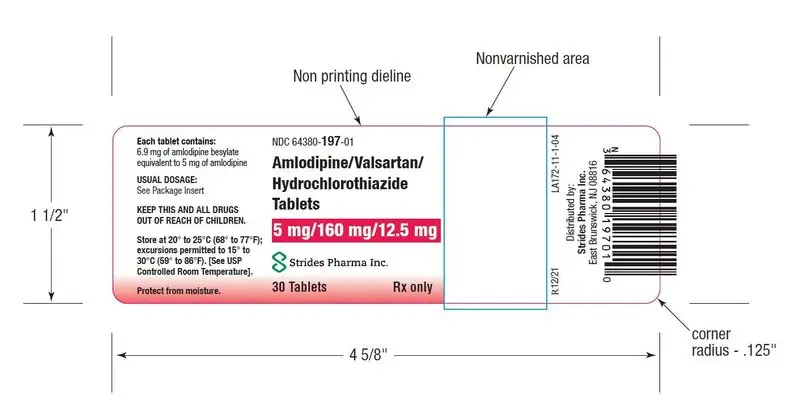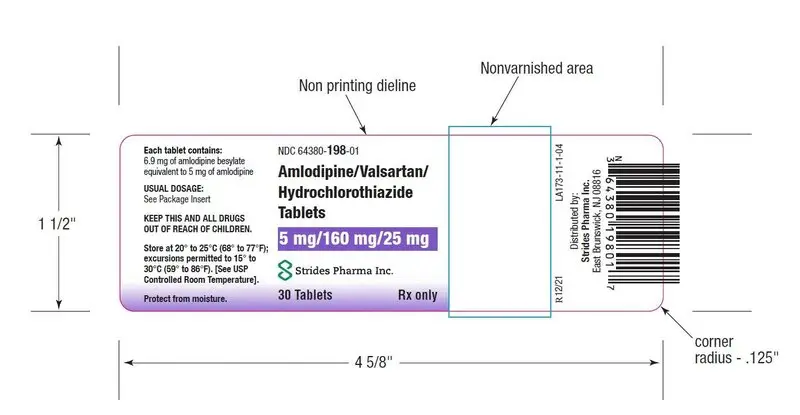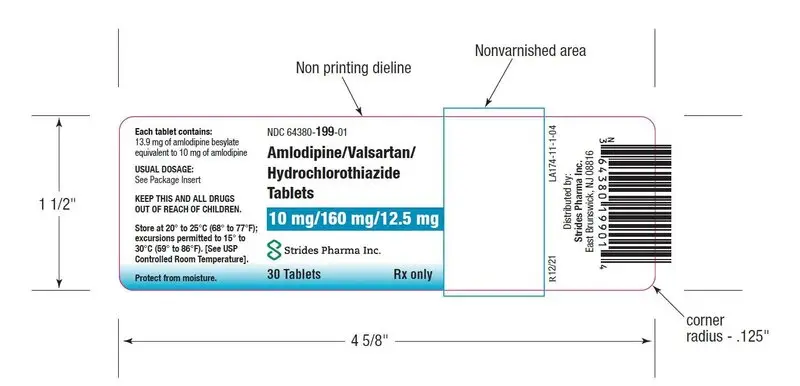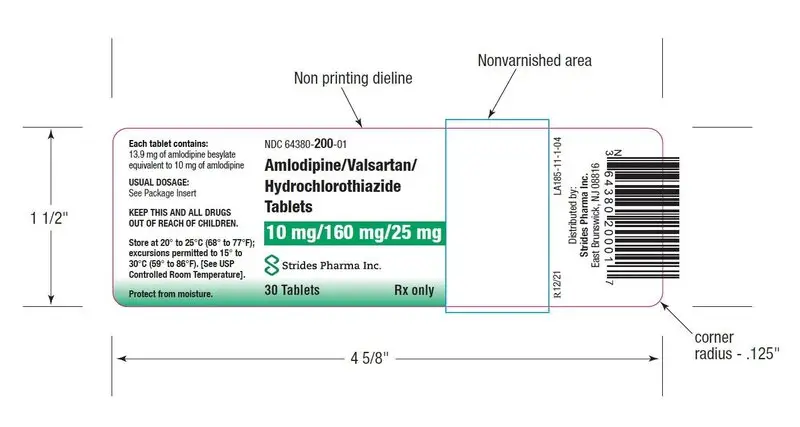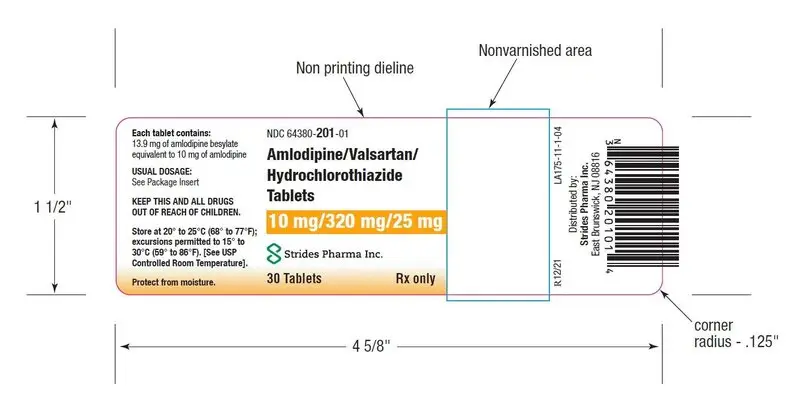Drug Class: Miscellaneous antihypertensive combinations
Highlights of Prescribing Information
AMLODIPINE/VALSARTAN/HYDROCHLOROTHIAZIDE tablets, for oral use
Initial U.S. Approval: 2009
Indications and Usage for Amlodipine, Valsartan, and Hydrochlorothiazide
- Amlodipine/valsartan/hydrochlorothiazide is a combination tablet of amlodipine, a dihydropyridine calcium channel blocker (DHP CCB), valsartan, an angiotensin II receptor blocker (ARB), and hydrochlorothiazide, a thiazide diuretic. Amlodipine/Valsartan/Hydrochlorothiazide is indicated for the treatment of hypertension to lower blood pressure. Lowering blood pressure reduces the risk of fatal and nonfatal cardiovascular events, primarily strokes, and myocardial infarctions. (1)
Limitation of Use (1)
Amlodipine/valsartan/hydrochlorothiazide is not indicated for initial treatment of hypertension. (1)
Amlodipine, Valsartan, and Hydrochlorothiazide Dosage and Administration
- Dose once-daily. Titrate up to a maximum dose of 10/320/25 mg. (2.1)
- Amlodipine/valsartan/hydrochlorothiazide may be used as add-on/switch therapy for patients not adequately controlled on any two of the following antihypertensive classes: calcium channel blockers, angiotensin receptor blockers, and diuretics. (2.2)
- Amlodipine/valsartan/hydrochlorothiazide may be substituted for its individually titrated components. (2.3)
Dosage Forms and Strengths
Tablets: (amlodipine/valsartan/hydrochlorothiazide mg) (3)
5/160/12.5 (3)
10/160/12.5 (3)
5/160/25 (3)
10/160/25 (3)
10/320/25 (3) (3)
Contraindications
- Anuria (4)
- Hypersensitivity to sulfonamide-derived drugs (4)
- Known hypersensitivity to any component (4)
- Do not coadminister aliskiren with amlodipine/valsartan/hydrochlorothiazide in patients with diabetes (4)
Warnings and Precautions
- Hypotension: Correct volume depletion prior to initiation (5.2)
- Increased angina and/or myocardial infarction (5.3)
- Monitor renal function and potassium in susceptible patients (5.4, 5.5)
- Exacerbation or activation of systemic lupus erythematosus (5.7)
- Observe for signs of fluid or electrolyte imbalance (5.9)
- Acute angle-closure glaucoma (5.10)
Adverse Reactions/Side Effects
Most common adverse events (≥2% incidence) are dizziness, peripheral edema, headache, dyspepsia, fatigue, muscle spasms, back pain, nausea and nasopharyngitis. (6.1) (6)
To report SUSPECTED ADVERSE REACTIONS, contact Strides Pharma Inc at 1-877-244-9825 and/or www.strides.com or FDA at 1-800-FDA-1088 or www.fda.gov/medwatch. (6)
Drug Interactions
- If simvastatin is coadministered with amlodipine, do not exceed doses greater than 20 mg daily of simvastatin. (7)
- Antidiabetic drugs: Dosage adjustment of antidiabetic may be required. (7)
- Cholestyramine and Colestipol: Reduced absorption of thiazides. (12.3)
- Lithium: Increased risk of lithium toxicity. Monitor serum lithium concentrations during concurrent use. (7)
- Non-Steroidal Anti-Inflammatory Drug (NSAID) use may lead to increased risk of renal impairment and loss of anti-hypertensive effect. (7)
- Dual inhibition of the renin-angiotension system: Increased risk of renal impairment, hypotension, and hyperkalemia. (7)
Use In Specific Populations
Lactation: Breastfeeding is not recommended (8.2) (8)
Geriatric Patients: Not recommended for initial therapy (8.5) (8)
Hepatic Impairment: Not recommended for initial therapy (8.7) (8)
See 17 for PATIENT COUNSELING INFORMATION.
Revised: 8/2022
Full Prescribing Information
WARNING: FETAL TOXICITY
• When pregnancy is detected, discontinue amlodipine/valsartan/hydrochlorothiazide as soon as possible (5.1).
• Drugs that act directly on the renin-angiotensin system can cause injury and death to the developing fetus (5.1).
1. Indications and Usage for Amlodipine, Valsartan, and Hydrochlorothiazide
Control of high blood pressure should be part of comprehensive cardiovascular risk management, including, as appropriate, lipid control, diabetes management, antithrombotic therapy, smoking cessation, exercise, and limited sodium intake. Many patients will require more than 1 drug to achieve blood pressure goals. For specific advice on goals and management, see published guidelines, such as those of the National High Blood Pressure Education Program's Joint National Committee on Prevention, Detection, Evaluation, and Treatment of High Blood Pressure (JNC).
Numerous antihypertensive drugs, from a variety of pharmacologic classes and with different mechanisms of action, have been shown in randomized controlled trials to reduce cardiovascular morbidity and mortality, and it can be concluded that it is blood pressure reduction, and not some other pharmacologic property of the drugs, that is largely responsible for those benefits. The largest and most consistent cardiovascular outcome benefit has been a reduction in the risk of stroke, but reductions in myocardial infarction and cardiovascular mortality also have been seen regularly.
Elevated systolic or diastolic pressure causes increased cardiovascular risk, and the absolute risk increase per mmHg is greater at higher blood pressures, so that even modest reductions of severe hypertension can provide substantial benefit. Relative risk reduction from blood pressure reduction is similar across populations with varying absolute risk, so the absolute benefit is greater in patients who are at higher risk independent of their hypertension (e.g., patients with diabetes or hyperlipidemia), and such patients would be expected to benefit from more aggressive treatment to a lower blood pressure goal.
Some antihypertensive drugs have smaller blood pressure effects (as monotherapy) in black patients, and many antihypertensive drugs have additional approved indications and effects (e.g., on angina, heart failure, or diabetic kidney disease). These considerations may guide selection of therapy.
Limitation of Use
Amlodipine/valsartan/hydrochlorothiazide is not indicated for the initial therapy of hypertension [see Dosage and Administration (2)].
2. Amlodipine, Valsartan, and Hydrochlorothiazide Dosage and Administration
2.2 Add-on/Switch Therapy
A patient who experiences dose-limiting adverse reactions to an individual component while on any dual combination of the components of amlodipine/valsartan/hydrochlorothiazide may be switched to amlodipine/valsartan/hydrochlorothiazide containing a lower dose of that component to achieve similar blood pressure reductions.
3. Dosage Forms and Strengths
Amlodipine/valsartan/hydrochlorothiazide tablets are available as follows:
- 5 mg amlodipine /160 mg valsartan /12.5 mg hydrochlorothiazide Tablets – White to off-white, film coated, oval shaped biconvex tablets, debossed with "P" on one side of the tablet and "172" on the other.
- 10 mg amlodipine /160 mg valsartan /12.5 mg hydrochlorothiazide Tablets – Peach to light brown, film coated, oval shaped biconvex tablets, debossed with "P" on one side of the tablet and "174" on the other.
- 5 mg amlodipine /160 mg valsartan /25 mg hydrochlorothiazide Tablets – Yellow, film-coated, oval shaped biconvex tablets debossed with "P" on one side of the tablet and "173" on the other.
- 10 mg amlodipine /160 mg valsartan /25 mg hydrochlorothiazide Tablets – Bright yellow, film-coated, oval shaped, biconvex tablets debossed with "P" on one side of the tablet and "185" on the other.
- 10 mg amlodipine /320 mg valsartan /25 mg hydrochlorothiazide Tablets – White to off-white, film coated, oval shaped biconvex tablets, debossed with "P" on one side of the tablet and "175" on the other.
4. Contraindications
Do not coadminister aliskiren with amlodipine/valsartan/hydrochlorothiazide in patients with diabetes [see Drug Interactions (7)].
5. Warnings and Precautions
5.1 Fetal Toxicity
Amlodipine/valsartan/hydrochlorothiazide can cause fetal harm when administered to a pregnant woman. Use of drugs that act on the renin-angiotensin system during the second and third trimesters of pregnancy reduces fetal renal function and increases fetal and neonatal morbidity and death. Resulting oligohydramnios can be associated with fetal lung hypoplasia and skeletal deformations. Potential neonatal adverse effects include skull hypoplasia, anuria, hypotension, renal failure, and death. When pregnancy is detected, discontinue Amlodipine/valsartan/hydrochlorothiazide as soon as possible[see Use in Specific Populations (8.1)].
Hydrochlorothiazide
Thiazides cross the placenta, and use of thiazides during pregnancy is associated with fetal or neonatal jaundice, thrombocytopenia, and possibly other adverse reactions that have occurred in adults.
5.2 Hypotension in Volume- or Salt-Depleted Patients
Amlodipine/valsartan/hydrochlorothiazide has not been studied in patients with heart failure, recent myocardial infarction, or in patients undergoing surgery or dialysis. Patients with heart failure or post-myocardial infarction patients given valsartan commonly have some reduction in blood pressure, but discontinuation of therapy because of continuing symptomatic hypotension usually is not necessary when dosing instructions are followed. In controlled trials in heart failure patients, the incidence of hypotension in valsartan-treated patients was 5.5% compared to 1.8% in placebo-treated patients. In the Valsartan in Acute Myocardial Infarction Trial (VALIANT), hypotension in post-myocardial infarction patients led to permanent discontinuation of therapy in 1.4% of valsartan-treated patients and 0.8% of captopril-treated patients.
Since the vasodilation induced by amlodipine is gradual in onset, acute hypotension has rarely been reported after oral administration. Do not initiate treatment with amlodipine/valsartan/hydrochlorothiazide in patients with aortic or mitral stenosis or obstructive hypertrophic cardiomyopathy.
If excessive hypotension occurs with amlodipine/valsartan/hydrochlorothiazide, place the patient in a supine position and, if necessary, give intravenous normal saline. A transient hypotensive response is not a contraindication to further treatment, which usually can be continued without difficulty once the blood pressure has stabilized.
5.5 Potassium Abnormalities
Some patients with heart failure have developed increases in potassium on valsartan. These effects are usually minor and transient, and they are more likely to occur in patients with pre-existing renal impairment. Dosage reduction and/or discontinuation of the diuretic and/or valsartan may be required.
Hydrochlorothiazide can cause hypokalemia and hyponatremia. Hypomagnesemia can result in hypokalemia which appears difficult to treat despite potassium repletion. Drugs that inhibit the renin-angiotensin system can cause hyperkalemia. Monitor serum electrolytes periodically.
If hypokalemia is accompanied by clinical signs (e.g., muscular weakness, paresis, or ECG alterations), amlodipine/valsartan/hydrochlorothiazide should be discontinued. Correction of hypokalemia and any coexisting hypomagnesemia is recommended prior to the initiation of thiazides.
5.9 Metabolic Imbalances
Hydrochlorothiazide may raise the serum uric acid level due to reduced clearance of uric acid and may cause or exacerbate hyperuricemia and precipitate gout in susceptible patients.
Hydrochlorothiazide decreases urinary calcium excretion and may cause elevations of serum calcium. Monitor calcium levels in patients with hypercalcemia receiving amlodipine/valsartan/hydrochlorothiazide.
6. Adverse Reactions/Side Effects
6.1 Clinical Trials Experience
In the controlled trial of amlodipine/valsartan/hydrochlorothiazide, where only the maximum dose (10/320/25 mg) was evaluated, safety data were obtained in 582 patients with hypertension. Adverse reactions have generally been mild and transient in nature and have only infrequently required discontinuation of therapy.
The overall frequency of adverse reactions was similar between men and women, younger (< 65 years) and older (≥ 65 years) patients, and black and white patients. In the active controlled clinical trial, discontinuation because of adverse events occurred in 4.0% of patients treated with amlodipine/valsartan/hydrochlorothiazide 10/320/25 mg compared to 2.9% of patients treated with valsartan/HCTZ 320/25 mg, 1.6% of patients treated with amlodipine/valsartan 10/320 mg, and 3.4% of patients treated with HCTZ/amlodipine 25/10 mg. The most common reasons for discontinuation of therapy with amlodipine/valsartan/hydrochlorothiazide were dizziness (1.0%) and hypotension (0.7%).
The most frequent adverse events that occurred in the active controlled clinical trial in at least 2% of patients treated with amlodipine/valsartan/hydrochlorothiazide are presented in the following table.
| Aml/Val/HCTZ
| Val/HCTZ
| Aml/Val
| HCTZ/Aml
|
|
| Preferred Term
| 10/320/25 mg
N=582 n (%) | 320/25 mg
N=559 n (%) | 10/320 mg
N=566 n (%) | 25/10 mg
N=561 n (%) |
| Dizziness
| 48 ( 8.2) | 40 ( 7.2) | 14 ( 2.5) | 23 ( 4.1) |
| Edema
| 38 ( 6.5) | 8 ( 1.4) | 65 (11.5) | 63 ( 11.2) |
| Headache
| 30 (5.2) | 31 (5.5) | 30 (5.3) | 40 (7.1) |
| Dyspepsia
| 13 ( 2.2) | 5 ( 0.9) | 6 ( 1.1) | 2 ( 0.4) |
| Fatigue
| 13 ( 2.2) | 15 ( 2.7) | 12 ( 2.1) | 8 ( 1.4) |
| Muscle spasms
| 13 ( 2.2) | 7 ( 1.3) | 7 ( 1.2) | 5 ( 0.9) |
| Back pain
| 12 ( 2.1) | 13 ( 2.3) | 5 ( 0.9) | 12 ( 2.1) |
| Nausea
| 12 ( 2.1) | 7 ( 1.3) | 10 ( 1.8) | 12 ( 2.1) |
| Nasopharyngitis
| 12 (2.1) | 13 (2.3) | 13 (2.3) | 12 (2.1) |
Orthostatic events (orthostatic hypotension and postural dizziness) were seen in 0.5% of patients.
Valsartan
Valsartan has been evaluated for safety in more than 4000 hypertensive patients in clinical trials. In trials in which valsartan was compared to an ACE inhibitor with or without placebo, the incidence of dry cough was significantly greater in the ACE inhibitor group (7.9%) than in the groups who received valsartan (2.6%) or placebo (1.5%). In a 129-patient trial limited to patients who had dry cough when they had previously received ACE inhibitors, the incidences of cough in patients who received valsartan, HCTZ, or lisinopril were 20%, 19%, and 69% respectively (p < 0.001).
Clinical Laboratory Test Findings
Clinical laboratory test findings for amlodipine/valsartan/hydrochlorothiazide were obtained in a controlled trial of amlodipine/valsartan/hydrochlorothiazide administered at the maximal dose of 10/320/25 mg compared to maximal doses of dual therapies, i.e., valsartan/HCTZ 320/25 mg, amlodipine/valsartan 10/320 mg, and HCTZ/amlodipine 25/10 mg. Findings for the components of amlodipine/valsartan/hydrochlorothiazide were obtained from other trials.
Creatinine: In heart failure patients, greater than 50% increases in creatinine were observed in 3.9% of valsartan-treated patients compared to 0.9% of placebo-treated patients. In post-myocardial infarction patients, doubling of serum creatinine was observed in 4.2% of valsartan-treated patients and 3.4% of captopril-treated patients.
Blood Urea Nitrogen (BUN): In hypertensive patients, greater than 50% increases in BUN were observed in 30% of amlodipine/valsartan/hydrochlorothiazide-treated patients compared to 29% of valsartan/HCTZ patients, 15.8% of amlodipine/valsartan patients, and 18.5% of HCTZ/amlodipine patients. In heart failure patients, greater than 50% increases in BUN were observed in 17% of valsartan-treated patients compared to 6% of placebo-treated patients [see Warnings and Precautions (5.4)].
Neutropenia: Neutropenia (< 1500/L) was observed in 1.9% of patients treated with valsartan and 0.8% of patients treated with placebo.
6.2 Postmarketing Experience
Amlodipine
With amlodipine, gynecomastia has been reported infrequently and a causal relationship is uncertain. Jaundice and hepatic enzyme elevations (mostly consistent with cholestasis or hepatitis), in some cases severe enough to require hospitalization, have been reported in association with use of amlodipine.
Valsartan
The following additional adverse reactions have been reported in postmarketing experience with valsartan or valsartan/hydrochlorothiazide:
Blood and Lymphatic: Decrease in hemoglobin, decrease in hematocrit, neutropenia
Hypersensitivity: Angioedema has been reported. Some of these patients previously experienced angioedema with other drugs including ACE inhibitors. Amlodipine/valsartan/hydrochlorothiazide should not be re-administered to patients who have had angioedema.
Digestive: Elevated liver enzymes and reports of hepatitis
Musculoskeletal: Rhabdomyolysis
Renal: Impaired renal function, renal failure
Dermatologic: Alopecia, bullous dermatitis
Vascular: Vasculitis
Nervous System: Syncope
Hydrochlorothiazide
The following additional adverse reactions have been reported in postmarketing experience with hydrochlorothiazide:
Acute renal failure, renal disorder, aplastic anemia, erythema multiforme, pyrexia, muscle spasm, asthenia, acute angle-closure glaucoma, bone marrow failure, worsening of diabetes control, hypokalemia, blood lipids increased, hyponatremia, hypomagnesemia, hypercalcemia, hypochloremic alkalosis, impotence, visual impairment.
Pathological changes in the parathyroid gland of patients with hypercalcemia and hypophosphatemia have been observed in a few patients on prolonged thiazide therapy. If hypercalcemia occurs, further diagnostic evaluation is necessary.
Non-melanoma Skin Cancer: Hydrochlorothiazide is associated with an increased risk of non-melanoma skin cancer. In a study conducted in the Sentinel System, increased risk was predominantly for squamous cell carcinoma (SCC) and in white patients taking large cumulative doses. The increased risk for SCC in the overall population was approximately 1 additional case per 16,000 patients per year, and for white patients taking a cumulative dose of ≥ 50,000 mg the risk increase was approximately 1 additional SCC case for every 6,700 patients per year.
7. Drug Interactions
Amlodipine
Impact of Other Drugs on Amlodipine
CYP3A Inhibitors
Coadministration with CYP3A inhibitors (moderate and strong) results in increased systemic exposure to amlodipine and may require dose reduction. Monitor for symptoms of hypotension and edema when amlodipine is coadministered with CYP3A inhibitors to determine the need for dose adjustment [see Clinical Pharmacology (12.3)].
CYP3A Inducers
No information is available on the quantitative effects of CYP3A inducers on amlodipine. Blood pressure should be closely monitored when amlodipine is coadministered with CYP3A inducers (e.g., rifampicin, St. John's Wort).
Sildenafil
Monitor for hypotension when sildenafil is coadministered with amlodipine [see Clinical Pharmacology (12.2)].
Impact of Amlodipine on Other Drugs
Simvastatin
Coadministration of simvastatin with amlodipine increases the systemic exposure of simvastatin. Limit the dose of simvastatin in patients on amlodipine to 20 mg daily [see Clinical Pharmacology (12.3)].
Immunosuppressants
Amlodipine may increase the systemic exposure of cyclosporine or tacrolimus when coadministered. Frequent monitoring of trough blood levels of cyclosporine and tacrolimus is recommended and adjust the dose when appropriate [see Clinical Pharmacology (12.3)].
Valsartan
Agents Increasing Serum Potassium: Concomitant use of valsartan with other agents that block the renin-angiotensin system, potassium-sparing diuretics (e.g., spironolactone, triamterene, amiloride), potassium supplements, salt substitutes containing potassium or other drugs that may increase potassium levels (e.g., heparin) may lead to increases in serum potassium and in heart failure patients to increases in serum creatinine. If co-medication is considered necessary, monitoring of serum potassium is advisable.
Non-Steroidal Anti-Inflammatory Agents Including Selective Cyclooxygenase-2 Inhibitors (COX-2 Inhibitors): In patients who are elderly, volume-depleted (including those on diuretic therapy), or with compromised renal function, coadministration of NSAIDs, including selective COX-2 inhibitors, with angiotensin II receptor antagonists, including valsartan, may result in deterioration of renal function, including possible acute renal failure. These effects are usually reversible. Monitor renal function periodically in patients receiving valsartan and NSAID therapy.
The antihypertensive effect of angiotensin II receptor antagonists, including valsartan, may be attenuated by NSAIDs including selective COX-2 inhibitors.
Dual Blockade of the Renin-Angiotensin System (RAS): Dual blockade of the RAS with angiotensin receptor blockers, ACE inhibitors, or aliskiren is associated with increased risks of hypotension, hyperkalemia, and changes in renal function (including acute renal failure) compared to monotherapy. Most patients receiving the combination of two RAS inhibitors do not obtain any additional benefit compared to monotherapy. In general, avoid combined use of RAS inhibitors. Closely monitor blood pressure, renal function and electrolytes in patients on valsartan and other agents that affect the RAS.
Do not coadminister aliskiren with valsartan in patients with diabetes. Avoid use of aliskiren with valsartan in patients with renal impairment (GFR < 60 mL/min).
Valsartan – Hydrochlorothiazide
Lithium: Increases in serum lithium concentrations and lithium toxicity have been reported during concomitant administration of lithium with angiotensin II receptor antagonists or thiazides. Monitor lithium levels in patients taking amlodipine, valsartan and hydrochlorothiazide.
Hydrochlorothiazide
When administered concurrently the following drugs may interact with thiazide diuretics:
Antidiabetic Drugs (oral agents and insulin): Dosage adjustment of the antidiabetic drug may be required.
Non-Steroidal Anti-inflammatory Drugs (NSAIDs and COX-2 selective inhibitors): When amlodipine/valsartan/hydrochlorothiazide and nonsteroidal anti-inflammatory agents are used concomitantly, the patient should be observed closely to determine if the desired effect of diuretic is obtained.
Carbamazepine: May lead to symptomatic hyponatremia.
Ion Exchange Resins: Staggering the dosage of hydrochlorothiazide and ion exchange resins (e.g., cholestyramine, colestipol) such that hydrochlorothiazide is administered at least 4 hours before or 4 to 6 hours after the administration of resins would potentially minimize the interaction [see Clinical Pharmacology (12.3)].
Cyclosporine: Concomitant treatment with cyclosporine may increase the risk of hyperuricemia and gout-type complications.
8. Use In Specific Populations
8.1 Pregnancy
Amlodipine/valsartan/hydrochlorothiazide can cause fetal harm when administered to a pregnant woman. Use of drugs that act on the renin-angiotensin system during the second and third trimesters of pregnancy reduces fetal renal function and increases fetal and neonatal morbidity and death. Most epidemiologic studies examining fetal abnormalities after exposure to antihypertensive use in the first trimester have not distinguished drugs affecting the renin-angiotensin system from other antihypertensive agents. Published reports include cases of anhydramnios and oligohydramnios in pregnant women treated with valsartan (see Clinical Considerations).
When pregnancy is detected, discontinue Amlodipine/valsartan/hydrochlorothiazide as soon as possible.
The estimated background risk of major birth defects and miscarriage for the indicated population is unknown. All pregnancies have a background risk of birth defect, loss, or other adverse outcomes. In the U.S. general population, the estimated background risk of major birth defects and miscarriage in clinically recognized pregnancies is 2-4% and 15-20%, respectively.
Clinical Considerations
Disease-Associated Maternal and/or Embryo/Fetal Risk
Hypertension in pregnancy increases the maternal risk for pre-eclampsia, gestational diabetes, premature delivery, and delivery complications (e.g., need for cesarean section, and post-partum hemorrhage). Hypertension increases the fetal risk for intrauterine growth restriction and intrauterine death. Pregnant women with hypertension should be carefully monitored and managed accordingly.
Fetal/Neonatal Adverse Reactions
Valsartan
Oligohydramnios in pregnant women who use drugs affecting the renin-angiotensin system in the second and third trimesters of pregnancy can result in the following: reduced fetal renal function leading to anuria and renal failure, fetal lung hypoplasia, skeletal deformations, including skull hypoplasia, hypotension and death.
Perform serial ultrasound examinations to assess the intra-amniotic environment. Fetal testing may be appropriate, based on the week of gestation. Patients and physicians should be aware, however, that oligohydramnios may not appear until after the fetus has sustained irreversible injury. If oligohydramnios is observed, consider alternative drug treatment. Closely observe neonates with histories of in utero exposure to Amlodipine/valsartan/hydrochlorothiazide for hypotension, oliguria, and hyperkalemia. In neonates with a history of in utero exposure to Amlodipine/valsartan/hydrochlorothiazide, if oliguria or hypotension occurs, support blood pressure and renal perfusion. Exchange transfusions or dialysis may be required as a means of reversing hypotension and replacing renal function.
Hydrochlorothiazide
Thiazides can cross the placenta, and concentrations reached in the umbilical vein approach those in the maternal plasma. Hydrochlorothiazide, like other diuretics, can cause placental hypoperfusion. It accumulates in the amniotic fluid, with reported concentrations up to 19 times higher than in umbilical vein plasma. Use of thiazides during pregnancy is associated with a risk of fetal or neonatal jaundice or thrombocytopenia. Since they do not prevent or alter the course of EPH (Edema, Proteinuria, Hypertension) gestosis (preeclampsia), these drugs should not be used to treat hypertension in pregnant women. The use of HCTZ for other indications (e.g., heart disease) in pregnancy should be avoided.
Data
Animal Data
Valsartan and Amlodipine
In rats, administered 20 mg/kg/day amlodipine plus 320 mg/kg/day valsartan, treatment-related maternal and fetal effects (developmental delays and alterations noted in the presence of significant maternal toxicity) were noted with the high dose combination. This corresponds to dose multiples of 9 and 19.5 times, respectively, the maximum recommended human dose (MRHD) of 10 mg/day for amlodipine and 320 mg/day for valsartan (based on body surface area and considering a 60 kg patient).
Hydrochlorothiazide
No teratogenic effects were observed when hydrochlorothiazide was administered to mice and rats via gavage at doses of up to 3,000 and 1,000 mg/kg/day (608 and 405 times the MRHD), on gestation days 6 through 15.
8.2 Lactation
There is limited information regarding the presence of Amlodipine/valsartan/hydrochlorothiazide in human milk, the effects on the breastfed infant, or the effects on milk production. Hydrochlorothiazide is present in human milk and valsartan is present in rat milk. Limited published studies report that amlodipine is present in human milk. Because of the potential for serious adverse reactions in breastfed infants, advise a nursing woman that breastfeeding is not recommended during treatment with Amlodipine/valsartan/hydrochlorothiazide.
Data
Valsartan was detected in the milk of lactating rats 15 minutes after oral administration of a 3 mg/kg dose.
8.5 Geriatric Use
Clinical studies of amlodipine besylate tablets did not include sufficient numbers of subjects aged 65 and over to determine whether they respond differently from younger subjects. Other reported clinical experience has not identified differences in responses between the elderly and younger patients. In general, dose selection for an elderly patient should be cautious, usually starting at the low end of the dosing range, reflecting the greater frequency of decreased hepatic, renal or cardiac function, and of concomitant disease or other drug therapy. Elderly patients have decreased clearance of amlodipine with a resulting increase of AUC of approximately 40% to 60% [see Clinical Pharmacology (12.3)]. The recommended starting dose of amlodipine 2.5 mg is not an available strength with amlodipine/valsartan/hydrochlorothiazide [see Clinical Studies (14)].
8.7 Hepatic Impairment
Exposure to amlodipine is increased in patients with hepatic insufficiency. The recommended initial dose of amlodipine in patients with hepatic impairment is 2.5 mg, which is not an available strength with amlodipine/valsartan/hydrochlorothiazide [see Clinical Pharmacology (12.3)].
Valsartan
No dose adjustment is necessary for patients with mild-to-moderate disease. No dosing recommendations can be provided for patients with severe liver disease.
Hydrochlorothiazide
Minor alterations of fluid and electrolyte balance may precipitate hepatic coma in patients with impaired hepatic function or progressive liver disease.
10. Overdosage
Amlodipine
Single oral doses of amlodipine maleate equivalent to 40 mg/kg and 100 mg/kg amlodipine in mice and rats, respectively, caused deaths. Single oral doses equivalent to 4 or more mg/kg amlodipine in dogs (11 or more times the MRHD on a mg/m2 basis) caused a marked peripheral vasodilation and hypotension.
Overdosage might be expected to cause excessive peripheral vasodilation with marked hypotension. In humans, experience with intentional overdosage of amlodipine is limited. Marked and potentially prolonged systemic hypotension up to and including shock with fatal outcome have been reported.
If massive overdose should occur, initiate active cardiac and respiratory monitoring. Frequent blood pressure measurements are essential. Should hypotension occur, initiate cardiovascular support, including elevation of the extremities and the judicious administration of fluids. If hypotension remains unresponsive to these conservative measures, consider administration of vasopressors (such as phenylephrine) with attention to circulating volume and urine output. As amlodipine is highly protein bound, hemodialysis is not likely to be of benefit. Administration of activated charcoal to healthy volunteers immediately or up to two hours after ingestion of amlodipine has been shown to significantly decrease amlodipine absorption.
Valsartan
Depressed level of consciousness, circulatory collapse, and shock have been reported.
Valsartan is not removed from the plasma by hemodialysis.
Valsartan was without grossly observable adverse effects at single oral doses up to 2,000 mg/kg in rats and up to 1,000 mg/kg in marmosets, except for salivation and diarrhea in the rat and vomiting in the marmoset at the highest dose (60 and 31 times, respectively, the MRHD on a mg/m2 basis) (Calculations assume an oral dose of 320 mg/day and a 60-kg patient).
Hydrochlorothiazide
The degree to which hydrochlorothiazide is removed by hemodialysis has not been established. The most common signs and symptoms observed in patients are those caused by electrolyte depletion (hypokalemia, hypochloremia, hyponatremia) and dehydration resulting from excessive diuresis. If digitalis has also been administered, hypokalemia may accentuate cardiac arrhythmias.
The oral LD50 of hydrochlorothiazide is greater than 10 g/kg in both mice and rats, 2000 and 4000 times, respectively, the MRHD on a mg/m2 basis (Calculations assume an oral dose of 25 mg/day and a 60-kg patient).
Valsartan and Hydrochlorothiazide
In rats and marmosets, single oral doses of valsartan up to 1524 and 762 mg/kg in combination with hydrochlorothiazide at doses up to 476 and 238 mg/kg, respectively, were very well tolerated without any treatment-related effects. These no adverse effect doses in rats and marmosets, respectively, represent 46.5 and 23 times the MRHD of valsartan and 188 and 113 times the MRHD of hydrochlorothiazide on a mg/m2 basis (Calculations assume an oral dose of 320 mg/day valsartan in combination with 25 mg/day hydrochlorothiazide and a 60 kg patient).
11. Amlodipine, Valsartan, and Hydrochlorothiazide Description
Amlodipine/valsartan/hydrochlorothiazide contains the besylate salt of amlodipine, a dihydropyridine calcium channel blocker (CCB). Amlodipine besylate, USP is a white to pale yellow crystalline powder, slightly soluble in water and sparingly soluble in ethanol. Amlodipine besylate's chemical name is 3-Ethyl 5-methyl (±)-2-[(2-aminoethoxy)methyl]4-(o-chlorophenyl)-1,4-dihydro-6-methyl-3,5-pyridinedicarboxylate, monobenzenesulfonate; its structural formula is:
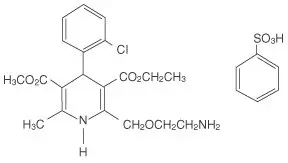
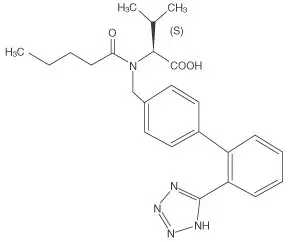
Its empirical formula is C24H29N5O3 and its molecular weight is 435.5.
Hydrochlorothiazide, USP is a white, or practically white, practically odorless, crystalline powder. It is slightly soluble in water; freely soluble in sodium hydroxide solution, in n-butylamine, and in dimethylformamide; sparingly soluble in methanol; and insoluble in ether, in chloroform, and in dilute mineral acids. Hydrochlorothiazide is chemically described as 6-chloro-3,4-dihydro-2H-1,2,4-benzothiadiazine-7-sulfonamide 1,1-dioxide.
Hydrochlorothiazide is a thiazide diuretic. Its empirical formula is C7H8ClN3O4S2, its molecular weight is 297.73, and its structural formula is:
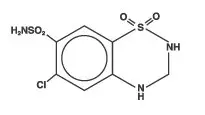
12. Amlodipine, Valsartan, and Hydrochlorothiazide - Clinical Pharmacology
12.1 Mechanism of Action
Amlodipine
Amlodipine is a dihydropyridine calcium channel blocker that inhibits the transmembrane influx of calcium ions into vascular smooth muscle and cardiac muscle. Experimental data suggest that amlodipine binds to both dihydropyridine and nondihydropyridine binding sites. The contractile processes of cardiac muscle and vascular smooth muscle are dependent upon the movement of extracellular calcium ions into these cells through specific ion channels. Amlodipine inhibits calcium ion influx across cell membranes selectively, with a greater effect on vascular smooth muscle cells than on cardiac muscle cells. Negative inotropic effects can be detected in vitro but such effects have not been seen in intact animals at therapeutic doses. Serum calcium concentration is not affected by amlodipine. Within the physiologic pH range, amlodipine is an ionized compound (pKa = 8.6), and its kinetic interaction with the calcium channel receptor is characterized by a gradual rate of association and dissociation with the receptor binding site, resulting in a gradual onset of effect.
Amlodipine is a peripheral arterial vasodilator that acts directly on vascular smooth muscle to cause a reduction in peripheral vascular resistance and reduction in blood pressure.
Valsartan
Angiotensin II is formed from angiotensin I in a reaction catalyzed by angiotensin-converting enzyme (ACE, kininase II). Angiotensin II is the principal pressor agent of the renin-angiotensin system, with effects that include vasoconstriction, stimulation of synthesis and release of aldosterone, cardiac stimulation, and renal reabsorption of sodium. Valsartan blocks the vasoconstrictor and aldosterone-secreting effects of angiotensin II by selectively blocking the binding of angiotensin II to the AT1 receptor in many tissues, such as vascular smooth muscle and the adrenal gland. Its action is therefore independent of the pathways for angiotensin II synthesis.
There is also an AT2 receptor found in many tissues, but AT2 is not known to be associated with cardiovascular homeostasis. Valsartan has much greater affinity (about 20000-fold) for the AT1 receptor than for the AT2 receptor. The increased plasma levels of angiotensin following AT1 receptor blockade with valsartan may stimulate the unblocked AT2 receptor. The primary metabolite of valsartan is essentially inactive with an affinity for the AT1 receptor about one-200th that of valsartan itself.
Blockade of the renin-angiotensin system with ACE inhibitors, which inhibit the biosynthesis of angiotensin II from angiotensin I, is widely used in the treatment of hypertension. ACE inhibitors also inhibit the degradation of bradykinin, a reaction also catalyzed by ACE. Because valsartan does not inhibit ACE (kininase II), it does not affect the response to bradykinin. Whether this difference has clinical relevance is not yet known. Valsartan does not bind to or block other hormone receptors or ion channels known to be important in cardiovascular regulation.
Blockade of the angiotensin II receptor inhibits the negative regulatory feedback of angiotensin II on renin secretion, but the resulting increased plasma renin activity and angiotensin II circulating levels do not overcome the effect of valsartan on blood pressure.
Hydrochlorothiazide
Hydrochlorothiazide is a thiazide diuretic. Thiazides affect the renal tubular mechanisms of electrolyte reabsorption, directly increasing excretion of sodium and chloride in approximately equivalent amounts. Indirectly, the diuretic action of hydrochlorothiazide reduces plasma volume, with consequent increases in plasma renin activity, increases in aldosterone secretion, increases in urinary potassium loss, and decreases in serum potassium. The renin-aldosterone link is mediated by angiotensin II, so coadministration of an angiotensin II receptor antagonist tends to reverse the potassium loss associated with these diuretics.
The mechanism of the antihypertensive effect of thiazides is unknown.
12.2 Pharmacodynamics
Amlodipine/valsartan/hydrochlorothiazide has not been studied in indications other than hypertension.
Amlodipine
Following administration of therapeutic doses to patients with hypertension, amlodipine produces vasodilation resulting in a reduction of supine and standing blood pressures. These decreases in blood pressure are not accompanied by a significant change in heart rate or plasma catecholamine levels with chronic dosing. Although the acute intravenous administration of amlodipine decreases arterial blood pressure and increases heart rate in hemodynamic studies of patients with chronic stable angina, chronic oral administration of amlodipine in clinical trials did not lead to clinically significant changes in heart rate or blood pressures in normotensive patients with angina.
With chronic, once-daily administration, antihypertensive effectiveness is maintained for at least 24 hours. Plasma concentrations correlate with effect in both young and elderly patients. The magnitude of reduction in blood pressure with amlodipine is also correlated with the height of pretreatment elevation; thus, individuals with moderate hypertension (diastolic pressure 105-114 mmHg) had about a 50% greater response than patients with mild hypertension (diastolic pressure 90-104 mmHg). Normotensive subjects experienced no clinically significant change in blood pressure (+1/-2 mmHg).
In hypertensive patients with normal renal function, therapeutic doses of amlodipine resulted in a decrease in renal vascular resistance and an increase in glomerular filtration rate and effective renal plasma flow without change in filtration fraction or proteinuria.
As with other calcium channel blockers, hemodynamic measurements of cardiac function at rest and during exercise (or pacing) in patients with normal ventricular function treated with amlodipine have generally demonstrated a small increase in cardiac index without significant influence on dP/dt or on left ventricular end diastolic pressure or volume. In hemodynamic studies, amlodipine has not been associated with a negative inotropic effect when administered in the therapeutic dose range to intact animals and man, even when coadministered with beta-blockers to man. Similar findings, however, have been observed in normal or well-compensated patients with heart failure with agents possessing significant negative inotropic effects.
Amlodipine does not change sinoatrial nodal function or atrioventricular conduction in intact animals or man. In patients with chronic stable angina, intravenous administration of 10 mg did not significantly alter A-H and H-V conduction and sinus node recovery time after pacing. Similar results were obtained in patients receiving amlodipine and concomitant beta-blockers. In clinical studies in which amlodipine was administered in combination with beta-blockers to patients with either hypertension or angina, no adverse effects of electrocardiographic (ECG) parameters were observed. In clinical trials with angina patients alone, amlodipine therapy did not alter ECG intervals or produce higher degrees of AV blocks.
Amlodipine has indications other than hypertension which are described in its full prescribing information.
Drug Interactions
Sildenafil
When amlodipine and sildenafil were used in combination, each agent independently exerted its own blood pressure lowering effect [see Drug Interactions (7)].
Valsartan
Valsartan inhibits the pressor effect of angiotensin II infusions. An oral dose of 80 mg inhibits the pressor effect by about 80% at peak with approximately 30% inhibition persisting for 24 hours. No information on the effect of larger doses is available.
Removal of the negative feedback of angiotensin II causes a 2- to 3-fold rise in plasma renin and consequent rise in angiotensin II plasma concentration in hypertensive patients. Minimal decreases in plasma aldosterone were observed after administration of valsartan; very little effect on serum potassium was observed.
Administration of valsartan to patients with essential hypertension results in a significant reduction of sitting, supine, and standing systolic blood pressure, usually with little or no orthostatic change.
Valsartan has indications other than hypertension which are described in its full prescribing information.
Hydrochlorothiazide
After oral administration of hydrochlorothiazide, diuresis begins within 2 hours, peaks in about 4 hours and lasts about 6 to 12 hours.
12.3 Pharmacokinetics
Amlodipine/Valsartan/Hydrochlorothiazide
Following oral administration of amlodipine/valsartan/hydrochlorothiazide in normal healthy adults, peak plasma concentrations of amlodipine, valsartan and HCTZ are reached in about 6 hours, 3 hours, and 2 hours, respectively. The rate and extent of absorption of amlodipine, valsartan and HCTZ from Amlodipine/valsartan/hydrochlorothiazide are the same as when administered as individual dosage forms.
The bioavailability of amlodipine, valsartan, and HCTZ were not altered when amlodipine/valsartan/hydrochlorothiazide was administered with food. Amlodipine/valsartan/hydrochlorothiazide may be administered with or without food.
Amlodipine
Peak plasma concentrations of amlodipine are reached 6 to 12 hours after administration of amlodipine alone. Absolute bioavailability has been estimated to be between 64% and 90%. The apparent volume of distribution of amlodipine is 21 L/kg. Approximately 93% of circulating amlodipine is bound to plasma proteins in hypertensive patients.
Amlodipine is extensively (about 90%) converted to inactive metabolites via hepatic metabolism with 10% of the parent compound and 60% of the metabolites excreted in the urine.
Elimination of amlodipine from the plasma is biphasic with a terminal elimination half-life of about 30 to 50 hours. Steady state plasma levels of amlodipine are reached after 7 to 8 days of consecutive daily dosing.
Valsartan
Following oral administration of valsartan alone peak plasma concentrations of valsartan are reached in 2 to 4 hours. Absolute bioavailability is about 25% (range 10% to 35%).
The steady state volume of distribution of valsartan after intravenous administration is 17 L indicating that valsartan does not distribute into tissues extensively. Valsartan is highly bound to serum proteins (95%), mainly serum albumin.
Valsartan shows biexponential decay kinetics following intravenous administration with an average elimination half-life of about 6 hours. The recovery is mainly as unchanged drug, with only about 20% of dose recovered as metabolites. The primary metabolite, accounting for about 9% of dose, is valeryl 4-hydroxy valsartan. In vitro metabolism studies involving recombinant CYP450 enzymes indicated that the CYP2C9 isoenzyme is responsible for the formation of valeryl-4-hydroxy valsartan. Valsartan does not inhibit CYP450 isozymes at clinically relevant concentrations. CYP450 mediated drug interaction between valsartan and coadministered drugs are unlikely because of the low extent of metabolism.
Valsartan, when administered as an oral solution, is primarily recovered in feces (about 83% of dose) and urine (about 13% of dose). Following intravenous administration, plasma clearance of valsartan is about 2 L/h and its renal clearance is 0.62 L/h (about 30% of total clearance).
Hydrochlorothiazide
The estimated absolute bioavailability of hydrochlorothiazide after oral administration is about 70%. Peak plasma hydrochlorothiazide concentrations (Cmax) are reached within 2 to 5 hours after oral administration. There is no clinically significant effect of food on the bioavailability of hydrochlorothiazide.
Hydrochlorothiazide binds to albumin (40% to 70%) and distributes into erythrocytes. Following oral administration, plasma hydrochlorothiazide concentrations decline biexponentially, with a mean distribution half-life of about 2 hours and an elimination half-life of about 10 hours.
About 70% of an orally administered dose of hydrochlorothiazide is eliminated in the urine as unchanged drug.
Specific Populations
Geriatric: Elderly patients have decreased clearance of amlodipine with a resulting increase in peak plasma levels, elimination half-life, and AUC. Exposure (measured by AUC) to valsartan is higher by 70% and the half-life is longer by 35% in the elderly than in the young. Limited amount of data suggest that the systemic clearance of hydrochlorothiazide is reduced in both healthy and hypertensive elderly subjects compared to young healthy volunteers.
Gender: Pharmacokinetics of valsartan do not differ significantly between males and females.
Race: Pharmacokinetic differences due to race have not been studied.
Renal Insufficiency: The pharmacokinetics of amlodipine are not significantly influenced by renal impairment. There is no apparent correlation between renal function (measured by creatinine clearance) and exposure (measured by AUC) to valsartan in patients with different degrees of renal impairment. Valsartan has not been studied in patients with severe impairment of renal function (creatinine clearance <10 mL/min). Valsartan is not removed from the plasma by hemodialysis.
In a study in individuals with impaired renal function, the mean elimination half-life of hydrochlorothiazide was doubled in individuals with mild/moderate renal impairment (30 < CrCl < 90 mL/min) and tripled in severe renal impairment (CrCl ≤ 30 mL/min), compared to individuals with normal renal function (CrCl > 90 mL/min) [see Use in Specific Populations (8.6)].
Hepatic Insufficiency: Patients with hepatic insufficiency have decreased clearance of amlodipine with resulting increase in AUC of approximately 40% to 60%. On average, patients with mild-to-moderate chronic liver disease have twice the exposure (measured by AUC values) to valsartan of healthy volunteers (matched by age, sex, and weight) [see Use in Specific Populations (8.7)].
Drug Interactions
Amlodipine:
In vitro data in human plasma indicate that amlodipine has no effect on the protein binding of digoxin, phenytoin, warfarin, and indomethacin.
Impact of Other Drugs on Amlodipine
Coadministered cimetidine, magnesium-and aluminum hydroxide antacids, sildenafil, and grapefruit juice have no impact on the exposure to amlodipine.
CYP3A Inhibitors: Coadministration of a 180 mg daily dose of diltiazem with 5 mg amlodipine in elderly hypertensive patients resulted in a 60% increase in amlodipine systemic exposure. Erythromycin coadministration in healthy volunteers did not significantly change amlodipine systemic exposure. However, strong inhibitors of CYP3A (e.g., itraconazole, clarithromycin) may increase the plasma concentrations of amlodipine to a greater extent [see Drug Interactions (7)].
Impact of Amlodipine on Other Drugs
Coadministered amlodipine does not affect the exposure to atorvastatin, digoxin, ethanol and the warfarin prothrombin response time.
Simvastatin: Coadministration of multiple doses of 10 mg of amlodipine with 80 mg simvastatin resulted in a 77% increase in exposure to simvastatin compared to simvastatin alone [see Drug Interactions (7)].
Cyclosporine: A prospective study in renal transplant patients (N = 11) showed on an average of 40% increase in trough cyclosporine levels when concomitantly treated with amlodipine [see Drug Interactions (7)].
Tacrolimus: A prospective study in healthy Chinese volunteers (N = 9) with CYP3A5 expressers showed a 2.5- to 4-fold increase in tacrolimus exposure when concomitantly administered with amlodipine compared to tacrolimus alone. This finding was not observed in CYP3A5 non-expressers (N = 6). However, a 3-fold increase in plasma exposure to tacrolimus in a renal transplant patient (CYP3A5 non-expresser) upon initiation of amlodipine for the treatment of post-transplant hypertension resulting in reduction of tacrolimus dose has been reported. Irrespective of the CYP3A5 genotype status, the possibility of an interaction cannot be excluded with these drugs [see Drug Interactions (7)].
Valsartan
No clinically significant pharmacokinetic interactions were observed when Diovan (valsartan) was coadministered with amlodipine, atenolol, cimetidine, digoxin, furosemide, glyburide, hydrochlorothiazide, or indomethacin. The valsartan-atenolol combination was more antihypertensive than either component, but it did not lower the heart rate more than atenolol alone.
Coadministration of valsartan and warfarin did not change the pharmacokinetics of valsartan or the time-course of the anticoagulant properties of warfarin.
Transporters: The results from an in vitro study with human liver tissue indicate that valsartan is a substrate of the hepatic uptake transporter OATP1B1 and the hepatic efflux transporter MRP2. Coadministration of inhibitors of the uptake transporter (rifampin, cyclosporine) or efflux transporter (ritonavir) may increase the systemic exposure to valsartan.
Hydrochlorothiazide:
Drugs That Alter Gastrointestinal Motility: The bioavailability of thiazide-type diuretics may be increased by anticholinergic agents (e.g., atropine, biperiden), apparently due to a decrease in gastrointestinal motility and the stomach emptying rate. Conversely, pro-kinetic drugs may decrease the bioavailability of thiazide diuretics.
Cholestyramine: In a dedicated drug interaction study, administration of cholestyramine 2 hours before hydrochlorothiazide resulted in a 70% reduction in exposure to hydrochlorothiazide. Further, administration of hydrochlorothiazide 2 hours before cholestyramine resulted in 35% reduction in exposure to hydrochlorothiazide.
Antineoplastic Agents (e.g., cyclophosphamide, methotrexate): Concomitant use of thiazide diuretics may reduce renal excretion of cytotoxic agents and enhance their myelosuppressive effects.
Alcohol, Barbiturates, or Narcotics: Potentiation of orthostatic hypotension may occur.
Skeletal Muscle Relaxants: Possible increased responsiveness to muscle relaxants, such as curare derivatives.
Digitalis Glycosides: Thiazide-induced hypokalemia or hypomagnesemia may predispose the patient to digoxin toxicity.
13. Nonclinical Toxicology
13.1 Carcinogenesis, Mutagenesis, Impairment of Fertility
Studies with Amlodipine: Rats and mice treated with amlodipine maleate in the diet for up to two years, at concentrations calculated to provide daily dosage levels of 0.5, 1.25, and 2.5 mg amlodipine/kg/day, showed no evidence of a carcinogenic effect of the drug. For the mouse, the highest dose was, on a mg/m2 basis, similar to the MRHD of 10 mg amlodipine/day. For the rat, the highest dose was, on a mg/m2 basis, about 2.5 times the MRHD. (Calculations based on a 60 kg patient).
Mutagenicity studies conducted with amlodipine maleate revealed no drug-related effects at either the gene or chromosome level.
There was no effect on the fertility of rats treated orally with amlodipine maleate (males for 64 days and females for 14 days prior to mating) at doses of up to 10 mg amlodipine/kg/day (about 10 times the MRHD of 10 mg/day on a mg/m2 basis).
Studies with Valsartan: There was no evidence of carcinogenicity when valsartan was administered in the diet to mice and rats for up to 2 years at concentrations calculated to provide doses of up to 160 and 200 mg/kg/day, respectively. These doses in mice and rats are about 2.4 and 6 times, respectively, the MRHD of 320 mg/day on a mg/m2 basis (Calculations based on a 60 kg patient).
Mutagenicity assays did not reveal any valsartan-related effects at either the gene or chromosome level. These assays included bacterial mutagenicity tests with Salmonella and E. coli, a gene mutation test with Chinese hamster V79 cells, a cytogenetic test with Chinese hamster ovary cells, and a rat micronucleus test.
Valsartan had no adverse effects on the reproductive performance of male or female rats at oral doses of up to 200 mg/kg/day. This dose is about 6 times the MRHD on a mg/m2 basis.
Studies with Hydrochlorothiazide: Two-year feeding studies in mice and rats conducted under the auspices of the National Toxicology Program (NTP) uncovered no evidence of a carcinogenic potential of hydrochlorothiazide in female mice (at doses of up to approximately 600 mg/kg/day) or in male and female rats (at doses of up to approximately 100 mg/kg/day). The NTP, however, found equivocal evidence for hepatocarcinogenicity in male mice.
Hydrochlorothiazide was not genotoxic in vitro in the Ames mutagenicity assay of Salmonella Typhimurium strains TA 98, TA 100, TA 1535, TA 1537, and TA 1538 and in the Chinese Hamster Ovary (CHO) test for chromosomal aberrations, or in vivo in assays using mouse germinal cell chromosomes, Chinese hamster bone marrow chromosomes, and the Drosophila sex-linked recessive lethal trait gene. Positive test results were obtained in the in vitro CHO Sister Chromatid Exchange (clastogenicity) and Mouse Lymphoma Cell (mutagenicity) assays and in the Aspergillus Nidulans non-disjunction assay.
Hydrochlorothiazide had no adverse effects on the fertility of mice and rats of either sex in studies wherein these species were exposed via diet at doses of up to 100 and 4 mg/kg, respectively, prior to mating and throughout gestation. These doses of hydrochlorothiazide in mice and rats are 19 and 1.5 times, respectively, the MRHD on a mg/m2 basis (Calculations assume an oral dose of 25 mg/day and a 60-kg patient).
14. Clinical Studies
At Week 8, the triple combination therapy produced greater reductions in blood pressure than each of the 3 dual combination treatments (p < 0.0001 for both diastolic and systolic blood pressures reductions). The reductions in systolic/ diastolic blood pressure with amlodipine/valsartan/hydrochlorothiazide were 7.6/5.0 mmHg greater than with valsartan/ HCTZ, 6.2/3.3 mmHg greater than with amlodipine/valsartan, and 8.2/5.3 mmHg greater than with amlodipine/HCTZ (see Figure 1). The full blood pressure lowering effect was achieved 2 weeks after being on the maximal dose of amlodipine/ valsartan/hydrochlorothiazide (see Figure 2 and Figure 3). As the pivotal study was an active-controlled trial, the treatment effects shown in Figures 1, 2, and 3 include a placebo effect of unknown size.


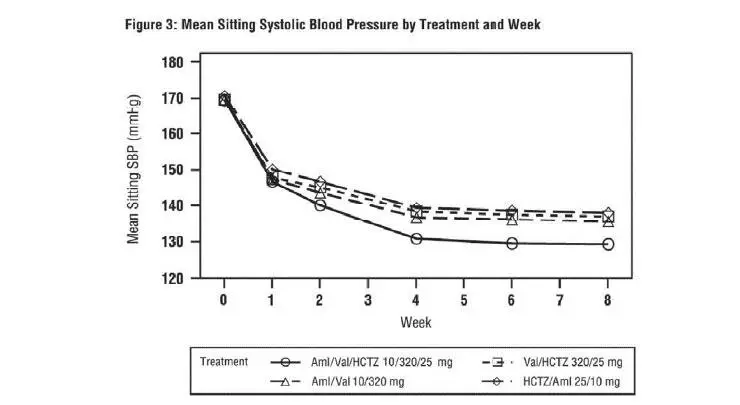
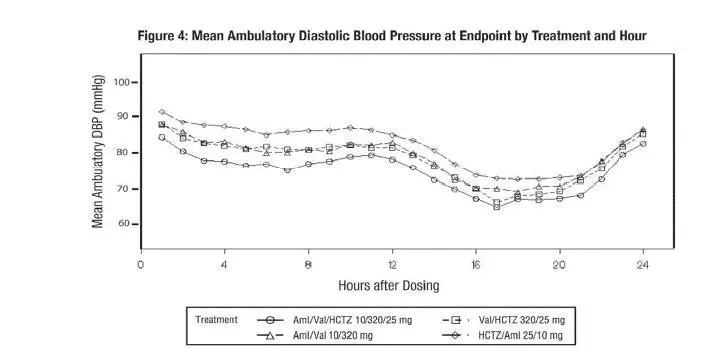
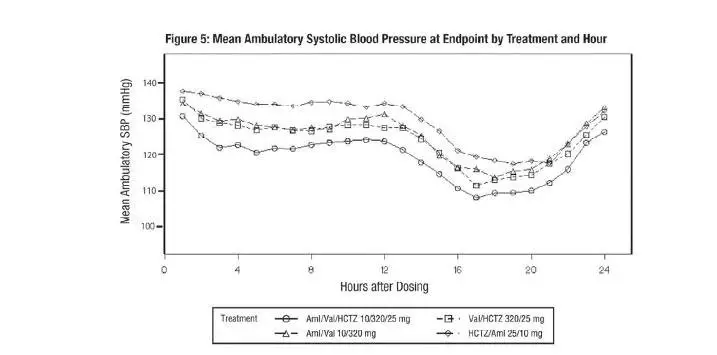
16. How is Amlodipine, Valsartan, and Hydrochlorothiazide supplied
5 mg amlodipine /160 mg valsartan /12.5 mg hydrochlorothiazide Tablets - White to off-white, film coated, oval shaped biconvex tablets, debossed with "P" on one side of the tablet and "172" on the other
Bottles of 30 NDC 64380-197-01
Bottles of 90 NDC 64380-197-02
Bottles of 500 NDC 64380-197-03
10 mg amlodipine /160 mg valsartan /12.5 mg hydrochlorothiazide Tablets – Peach to light brown, film coated, oval shaped biconvex tablets, debossed with "P" on one side of the tablet and "174" on the other.
Bottles of 30 NDC 64380-199-01
Bottles of 90 NDC 64380-199-02
Bottles of 500 NDC 64380-199-03
5 mg amlodipine /160 mg valsartan /25 mg hydrochlorothiazide Tablets – Yellow, film-coated, oval shaped biconvex tablets debossed with "P" on one side of the tablet and "173" on the other.
Bottles of 30 NDC 64380-198-01
Bottles of 90 NDC 64380-198-02
Bottles of 500 NDC 64380-198-03
10 mg amlodipine /160 mg valsartan /25 mg hydrochlorothiazide Tablets – Bright yellow, film-coated oval shaped, biconvex tablets debossed with "P" on one side of the tablet and "185" on the other.
Bottles of 30 NDC 64380-200-01
Bottles of 90 NDC 64380-200-02
Bottles of 500 NDC 64380-200-03
10 mg amlodipine /320 mg valsartan /25 mg hydrochlorothiazide Tablets – White to off-white, film coated, oval shaped biconvex tablets, debossed with "P" on one side of the tablet and "175" on the other
Bottles of 30 NDC 64380-201-01
Bottles of 90 NDC 64380-201-02
Bottles of 500 NDC 64380-201-03
Store at 20° to 25°C (68° to 77°F); excursions permitted to 15º to 30°C (59º to 86°F)
[see USP Controlled Room Temperature.]
Protect from moisture.
Dispense in tight container (USP).
17. Patient Counseling Information
Advise the patient to read the FDA-approved patient labeling (Patient Information).
Pregnancy: Advise female patients of childbearing age about the consequences of exposure to amlodipine/valsartan/ hydrochlorothiazide during pregnancy. Discuss treatment options with women planning to become pregnant. Ask patients to report pregnancies to their physicians as soon as possible [see Warnings and Precautions (5.1) and Use in Specific Populations (8.1)]
Lactation: Advise women not to breastfeed during treatment with amlodipine/valsartan/hydrochlorothiazide [see Use in Specific Populations (8.2)].
Symptomatic Hypotension: Advise patients that lightheadedness can occur, especially during the first days of therapy, and that it should be reported to their healthcare provider. Tell patients that if syncope occurs to discontinue amlodipine/valsartan/ hydrochlorothiazide until the physician has been consulted. Caution all patients that inadequate fluid intake, excessive perspiration, diarrhea, or vomiting can lead to an excessive fall in blood pressure, with the same consequences of lightheadedness and possible syncope [see Warnings and Precautions (5.2)].
Potassium Supplements: Advise patients not to use salt substitutes without consulting their healthcare provider [see Drug Interactions (7)].
Non-melanoma Skin Cancer: Instruct patients taking hydrochlorothiazide to protect skin from the sun and undergo regular skin cancer screening [see Adverse Reactions (6.2)].
Information for Patients
| Patient Information
Amlodipine/Valsartan/Hydrochlorothiazide (am-LOE-di-peen, val-SAR-tan, HYE-droe-klor-oh THYE-a-zide) Tablets |
| Read the Patient Information that comes with amlodipine/valsartan/hydrochlorothiazide before you start taking it and each time you get a refill. There may be new information. This leaflet does not take the place of talking with your doctor about your medical condition or treatment. What is the most important information I should know about Amlodipine/ Valsartan/Hydrochlorothiazide?
What is Amlodipine/Valsartan/Hydrochlorothiazide? Amlodipine/valsartan/hydrochlorothiazide contains 3 prescription medicines:
Amlodipine/valsartan/hydrochlorothiazide has not been studied in children under 18 years of age. Who should not take Amlodipine/Valsartan/Hydrochlorothiazide? Do not take Amlodipine/Valsartan/Hydrochlorothiazide if you have low or no urine output (anuria). What should I tell my doctor before taking Amlodipine/Valsartan/Hydrochlorothiazide? Tell your doctor about all of your medical conditions, including if you:
Especially tell your doctor if you take: ● simvastatin or other cholesterol-lowering medicine ● other medicines for high blood pressure or a heart problem ● water pills ("diuretics") ● potassium supplements. Your doctor may check the amount of potassium in your blood periodically. ● salt substitute containing potassium. Your doctor may check the amount of potassium in your blood periodically. ● diabetes medicine, including insulin ● narcotic pain medicines ● sleeping pills and antiseizure medicines called barbiturates ● lithium, a medicine used to treat some types of depression ● aspirin or other medicines called nonsteroidal anti-inflammatory drugs (NSAIDs), like ibuprofen or naproxen ● steroids ● alcohol ● digoxin or other digitalis glycosides (a heart medicine) ● muscle relaxants (medicines used during operations) ● certain cancer medicines, like cyclophosphamide or methotrexate ● medicines used to prevent and treat fungal infections (such as ketoconazole, itraconazole). ● medicines used to treat bacterial infections (such as clarithromycin, telithromycin) ● certain antibiotics (rifamycin group), a drug used to protect against transplant rejection (cyclosporine) or an antiretroviral drug used to treat HIV/AIDS infection (ritonavir). These drugs may increase the effect of valsartan. Know the medicines you take. Keep a list of your medicines and show it to your doctor or pharmacist when you get a new medicine. How should I take Amlodipine/Valsartan/Hydrochlorothiazide?
○ go for kidney dialysis What are the possible side effects of Amlodipine/Valsartan/Hydrochlorothiazide? Amlodipine/valsartan/hydrochlorothiazide may cause serious side effects including:
○ are on a low-salt diet ○ have heart problems ○ get dialysis treatments ○ get sick with vomiting or diarrhea ○ drink alcohol Lie down if you feel faint or dizzy. If you faint (lose consciousness), stop taking amlodipine/valsartan/hydrochlorothiazide. Call your doctor right away.
o eye pain The most common side effects of amlodipine/valsartan/hydrochlorothiazide include:
Tell your doctor if you have any side effect that bothers you or that does not go away. These are not all the possible side effects of amlodipine/valsartan/hydrochlorothiazide. For more information, ask your doctor or pharmacist. Call your doctor for medical advice about side effects. You may report side effects to FDA at 1-800-FDA-1088. How should I store Amlodipine/Valsartan/Hydrochlorothiazide?
General Information about Amlodipine/Valsartan/Hydrochlorothiazide Medicines are sometimes prescribed for conditions that are not mentioned in the patient information leaflet. Do not use amlodipine/valsartan/hydrochlorothiazide for a condition for which it was not prescribed. Do not give amlodipine/valsartan/ hydrochlorothiazide to other people, even if they have the same symptoms that you have. It may harm them. This patient information leaflet summarizes the most important information about amlodipine/valsartan/hydrochlorothiazide. If you would like more information about amlodipine/valsartan/hydrochlorothiazide, talk with your doctor. You can ask your doctor or pharmacist for information about amlodipine/valsartan/hydrochlorothiazide that is written for health professionals. For more information go to www.strides.com or call 1-877-244-9825 . What are the ingredients in Amlodipine/Valsartan/Hydrochlorothiazide? Active ingredients: amlodipine besylate, valsartan and hydrochlorothiazide The inactive ingredients for all strengths of the tablets include microcrystalline cellulose, crospovidone, colloidal silicon dioxide, and magnesium stearate, Additionally, the 5/160/12.5 mg strength contains polyethylene glycol, polyvinyl alcohol, lactose monohydrate, triethyl citrate, hypromellose, titanium dioxide and talc; the 10/320/25 mg strength contains the same ingredients as the 5/160/12.5 mg strength with the exception of the talc; the 5/160/25 mg strength contains lactose monohydrate, hypromellose, triacetin, D&C Yellow #10, titanium dioxide, and FD&C Yellow #6; the 10/160/12.5 mg strength contains FD&C Yellow #6, triethyl citrate, yellow iron oxide, hypromellose and titanium dioxide; and the 10/160/25 mg strength contains hypromellose, titanium dioxide, D&C Yellow #10, macrogol and polysorbate. What is high blood pressure (hypertension)? Blood pressure is the force of blood in your blood vessels when your heart beats and when your heart rests. You have high blood pressure when the force is too much. Amlodipine/valsartan/hydrochlorothiazide can help your blood vessels relax so your blood pressure is lower. Medicines that lower blood pressure lower your chance of having a stroke or heart attack. High blood pressure makes the heart work harder to pump blood throughout the body and causes damage to blood vessels. If high blood pressure is not treated, it can lead to stroke, heart attack, heart failure, kidney failure and vision problems. Distributed by: Strides Pharma Inc. East Brunswick, NJ 0881 Revised: 07/22 OS172-01-1-06 |
| AMLODIPINE, VALSARTAN, HYDROCHLOROTHIAZIDE
amlodipine besylate valsartan hydrochlorothiazide tablet, film coated |
||||||||||||||||||||||||||||
|
||||||||||||||||||||||||||||
|
||||||||||||||||||||||||||||
|
||||||||||||||||||||||||||||
|
||||||||||||||||||||||||||||
|
||||||||||||||||||||||||||||
|
||||||||||||||||||||||||||||
| AMLODIPINE, VALSARTAN, HYDROCHLOROTHIAZIDE
amlodipine besylate valsartan hydrochlorothiazide tablet, film coated |
|||||||||||||||||||||||||
|
|||||||||||||||||||||||||
|
|||||||||||||||||||||||||
|
|||||||||||||||||||||||||
|
|||||||||||||||||||||||||
|
|||||||||||||||||||||||||
|
|||||||||||||||||||||||||
| AMLODIPINE, VALSARTAN, HYDROCHLOROTHIAZIDE
amlodipine besylate valsartan hydrochlorothiazide tablet, film coated |
|||||||||||||||||||||||||
|
|||||||||||||||||||||||||
|
|||||||||||||||||||||||||
|
|||||||||||||||||||||||||
|
|||||||||||||||||||||||||
|
|||||||||||||||||||||||||
|
|||||||||||||||||||||||||
| AMLODIPINE, VALSARTAN, HYDROCHLOROTHIAZIDE
amlodipine besylate valsartan hydrochlorothiazide tablet, film coated |
|||||||||||||||||||||||||
|
|||||||||||||||||||||||||
|
|||||||||||||||||||||||||
|
|||||||||||||||||||||||||
|
|||||||||||||||||||||||||
|
|||||||||||||||||||||||||
|
|||||||||||||||||||||||||
| AMLODIPINE, VALSARTAN, HYDROCHLOROTHIAZIDE
amlodipine besylate valsartan hydrochlorothiazide tablet, film coated |
|||||||||||||||||||||||||
|
|||||||||||||||||||||||||
|
|||||||||||||||||||||||||
|
|||||||||||||||||||||||||
|
|||||||||||||||||||||||||
|
|||||||||||||||||||||||||
|
|||||||||||||||||||||||||
| Labeler - Strides Pharma Science Limited (650738743) |




